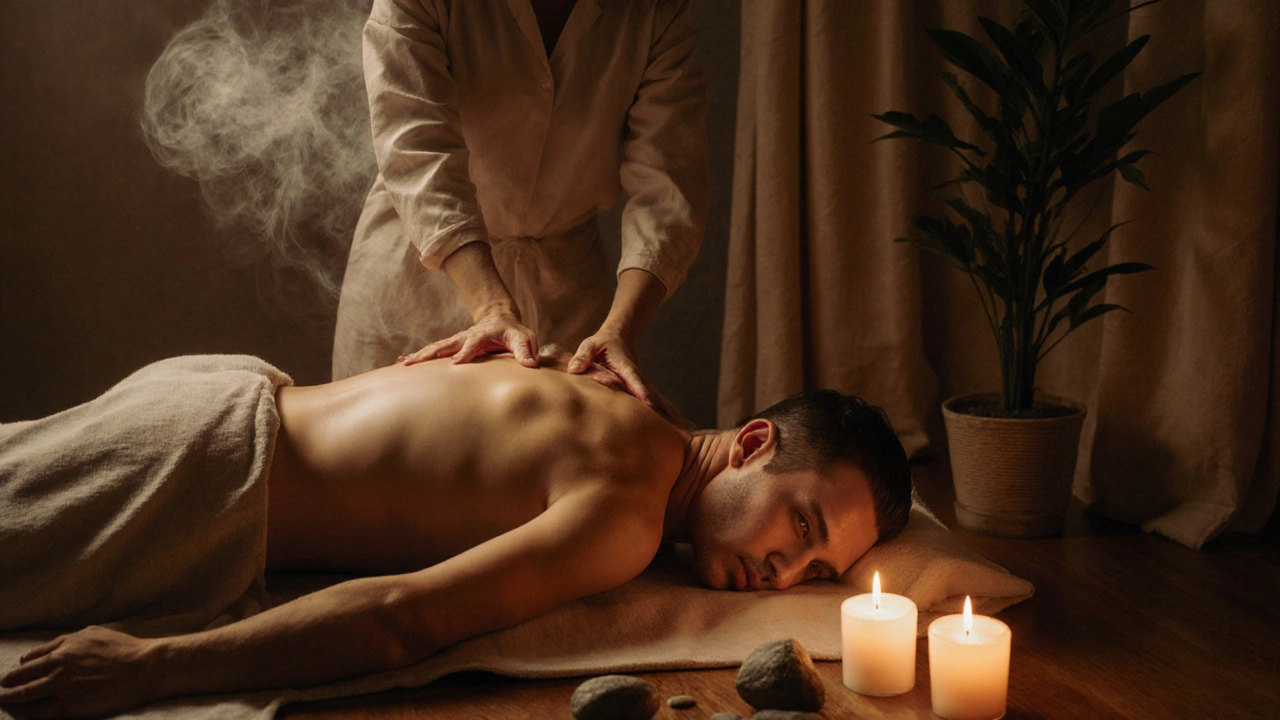Tantric Massage: A Sensual Path to Inner Peace and Fulfillment

You’ve heard whispers about tantric massage-maybe from a friend who swore it changed their life, or a quiet ad tucked between yoga studios and crystal shops. But what does it really feel like? And why are so many people saying it’s not just about touch, but about transformation?
Here’s the truth: tantric massage isn’t sex. It’s not even really about pleasure in the way most people think of it. It’s about tantric massage as a slow, sacred return to your own body-where tension dissolves, breath returns, and you remember what it feels like to be fully present.
What Is Tantric Massage, Really?
Tantric massage comes from ancient Indian and Tibetan spiritual traditions that saw the body not as a temple to be purified, but as a vessel of energy to be awakened. Unlike Swedish or deep tissue massage, it doesn’t aim to fix sore muscles. Instead, it invites you into a state of deep awareness-where every touch, every pause, every breath becomes part of a larger experience.
This isn’t a quick 60-minute escape. It’s a journey. A skilled practitioner uses slow, intentional strokes, often starting with the feet or back, gradually moving toward more sensitive areas-not to excite, but to expand your capacity for sensation. The goal? To help you feel more than just skin-deep. To reconnect with the subtle currents of energy that flow through you, the same ones yoga and meditation try to awaken.
And yes-it’s sensual. But not in the way you might expect. It’s the kind of sensuality that makes you notice how your shoulder feels when the oil warms on your skin, or how your breath slows when someone holds your hand without saying a word.
Why People Seek Tantric Massage Today
Life is loud. Phones buzz. Work piles up. Relationships get routine. Many people come to tantric massage not because they’re looking for romance, but because they’re exhausted-emotionally, physically, spiritually.
One client, a 42-year-old teacher from Berlin, told me: "I hadn’t felt truly relaxed in years. Not because I was stressed, but because I didn’t know how to stop being on guard." That’s common. We spend so much time managing our emotions, hiding our needs, that we forget how to just be.
Tantric massage offers a rare space: no judgment, no expectations, no performance. You’re not there to impress anyone. You’re there to receive. And in that quiet receiving, something shifts.
Studies on somatic therapy show that prolonged, non-sexual touch can lower cortisol levels, increase oxytocin, and help regulate the nervous system. Tantric massage works on that level-not as a quick fix, but as a reset button for your entire system.
What Happens During a Session?
Most sessions last 90 to 120 minutes. You’ll begin by talking briefly-just enough for the practitioner to understand your boundaries and intentions. You’ll undress privately and lie on a warmed table, covered with a towel. The room is soft-lit, maybe with incense or calming music.
The massage starts with grounding-gentle strokes along your legs, feet, or spine. The touch is slow, deliberate. There’s no rush. The practitioner might guide your breath, or simply hold space while you breathe. As the session continues, they may use warm oil, feathers, or even sound bowls to deepen your awareness.
Some people worry about what happens with intimate areas. The truth? In a professional tantric session, the focus is on energy flow, not genital stimulation. If the practitioner moves toward sensitive zones, it’s with the same slow, respectful attention they used on your back. Many clients report feeling a wave of warmth, tingling, or even emotional release-not from arousal, but from deep relaxation.
It’s not unusual to cry. Or laugh. Or fall asleep. That’s not a sign something went wrong. It’s a sign your body finally felt safe enough to let go.
How Tantric Massage Differs From Other Massage Types
Let’s be clear: this isn’t a spa day. It’s not Thai massage with pressure points. It’s not a romantic couple’s massage with candlelight and champagne. It’s something else entirely.
| Aspect | Tantric Massage | Swedish Massage | Deep Tissue | Body-to-Body Massage |
|---|---|---|---|---|
| Primary Goal | Energy awareness, emotional release, presence | Relaxation, muscle tension relief | Chronic pain, deep muscle knots | Sensual pleasure, intimacy |
| Touch Style | Slow, intentional, non-goal-oriented | Flowing, rhythmic | Firm, focused pressure | Full-body contact, often nude |
| Energy Work | Yes-chakras, breath, subtle energy | No | No | Usually no |
| Sexual Intent | No-sensual, not sexual | No | No | Often yes |
| Duration | 90-120 minutes | 60-90 minutes | 60-90 minutes | 60-90 minutes |
Unlike body-to-body massage-which often blurs lines between therapy and erotic service-tantric massage keeps boundaries clear. The practitioner is trained, not seductive. The environment is clinical, not romantic. And the outcome? Not orgasm. But something deeper: a quiet sense of wholeness.

Who Benefits Most From Tantric Massage?
You don’t need to be spiritual. You don’t need to believe in chakras. You just need to be tired of living in your head.
People who benefit most:
- Those recovering from trauma or emotional numbness
- People who struggle with intimacy or feel disconnected from their bodies
- High-performers who’ve burned out from constant doing
- Those who’ve lost touch with pleasure outside of sex
- Anyone who feels like they’ve forgotten how to breathe
It’s not for everyone. If you’re looking for a quick fix, or if you’re uncomfortable with silence, this might not be your thing. But if you’ve ever sat in a quiet room and wondered why you feel so alone-even when you’re not-this might be exactly what you need.
How to Find a Reputable Tantric Massage Practitioner
This isn’t something you book on a random app. Trust matters more than price.
Start by looking for practitioners who:
- Have formal training in tantric or somatic therapy (not just a weekend workshop)
- Offer a pre-session consultation
- Work in a clean, private space-not a hotel room or Airbnb
- Are transparent about boundaries and consent
- Don’t promise "sexual awakening" or "orgasmic release"-those are red flags
Search terms like "certified tantric therapist," "somatic bodywork," or "energy-based massage" work better than "tantric massage near me." Look for reviews that mention safety, professionalism, and emotional depth-not just "amazing touch."
In cities like Amsterdam, Berlin, or Portland, there are established studios with trained practitioners. Don’t be afraid to ask: "What’s your training? How do you handle boundaries?" A good practitioner won’t mind. In fact, they’ll welcome it.
What to Expect After Your First Session
Some people feel light, floating, almost euphoric. Others feel raw-like they’ve been peeled open. That’s normal.
You might cry on the way home. You might feel unusually tired. You might not want to talk to anyone for a day. Or you might suddenly notice how beautiful the sky looks, or how warm your coffee feels in your hands.
These aren’t side effects. They’re signs your nervous system is recalibrating. Give yourself space. Drink water. Avoid screens for a few hours. Let the experience settle.
Most people don’t need more than one or two sessions to feel a shift. But those who return? They come back not because they’re addicted to the touch-but because they finally remember what it feels like to be at home in their own skin.

Myths About Tantric Massage-Busted
Let’s clear up the noise:
- Myth: It’s a front for prostitution. Truth: Reputable tantric practitioners follow strict ethical codes. Many are licensed therapists. The industry is regulated in places like the Netherlands and Germany.
- Myth: You’ll have an orgasm. Truth: Some people do. Many don’t. The goal isn’t climax-it’s presence.
- Myth: You need to be spiritual. Truth: You just need to be willing to feel.
- Myth: It’s only for couples. Truth: Most sessions are one-on-one with a trained professional. Couples work is rare and requires special training.
Frequently Asked Questions
Is tantric massage legal?
Yes, in most countries-including the Netherlands, Germany, Canada, and parts of the U.S.-as long as it’s performed by a trained professional in a regulated setting. Legitimate tantric massage is considered a form of somatic therapy, not sexual service. Always check local laws and choose practitioners with clear ethical guidelines.
Can I do tantric massage at home with my partner?
You can try, but it’s not the same. Tantric massage requires training in energy awareness, boundaries, and non-goal-oriented touch. Most couples who try it on their own end up falling back into sex or performance. If you’re interested, start with guided breathwork or mindful touch exercises-then consider a professional session to learn the foundation.
How much does a tantric massage cost?
Prices vary by location and practitioner experience. In cities like Amsterdam or Berlin, expect to pay between €120 and €200 for a 90-minute session. Higher prices often reflect advanced training, longer sessions, or therapist certification. Avoid anything under €80-it’s usually a red flag.
Do I have to be naked?
Most sessions involve full nudity, but you’re always covered with a towel except for the area being worked on. Your comfort comes first. You can keep underwear on if that helps you feel safer. A good practitioner will never pressure you.
Is tantric massage safe for trauma survivors?
It can be-but only with the right practitioner. Look for someone trained in trauma-informed bodywork. They’ll prioritize your autonomy, offer clear boundaries, and let you control the pace. Many trauma survivors report profound healing through this work, but it’s essential to choose carefully.
Ready to Feel Again?
You don’t need to believe in energy fields. You don’t need to be spiritual. You just need to be tired of feeling like you’re living in a fog.
Tantric massage doesn’t promise miracles. But it does offer something rarer: a quiet, deep, undeniable sense of being held-not by someone else, but by your own body, finally awake.
If you’ve been searching for peace-not distraction, not escape, but real, quiet peace-this might be the path you’ve been walking toward without knowing it.


